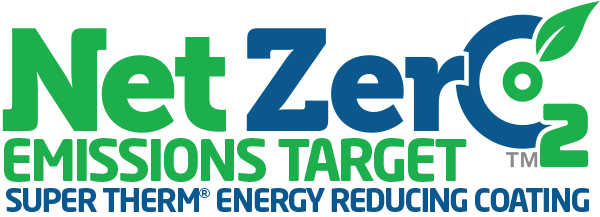Super Therm® Testing & Results
Super Therm® Extensive Testing – Outstanding Quality Insulation Coating
Super Therm® Fire, Moisture and Mould Testing
Super Therm® Diverse Testing Performance
- Exterior insulation against Solar Radiation:
US Energy Authority tested - Diffusivity – blocks 99.5% of infrared (ASTM E1269 & ASTM E1461-92): 25°C, 50°C, 75°C, 100°C
- Sound/acoustic blockage (ASTM E90): 50-68% sound reduction
- UL (Underwriters Laboratory) approved: Infrared Analysis; Qualitative (IR). Also tested UL 723 (ASTM E84): Test for Surface Burning Characteristics of Building Materials and UL 790 (ASTM E108): Standard Test Methods for Fire Tests of Roof Coverings
- Flame Spread Test (ASTM E84): NASA Test Smoke 0, Flame Spread 0, Class ‘A’
- Class “A” Flame Spread (AS/NZS 1530.3): Ignition time: Nil; Flame Propagation: Nil; Heat Release: Nil
- Marine Approvals ABS: Meets Parts 2 (Smoke & Toxicity) and 5 (Surface Flammability) of the IMO FTP Code, 2010
- UV & Salt Spray Resistance (ASTM 5894): 5000 hours – no signs of blistering
- USDA Approved: Food Safety and Inspection Service Approval
- Adhesion ASTM (D4541): 191psi (13.37 bar) @ 250 microns dry (10 mils) – Result is rated over 480km (300 mph) wind force
- Perm Rating (ASTM D1653-13): 250 microns/0.25mm = 8 perms; 300 microns/0.30mm = 4 perms
- Abrasion Resistance (ASTM D4060): 3,000 cycles
- Resistance to Salt Spray (ASTM B117): 450 hours
- Resistance to Wind Driven Rain (ASTM D6904): Conforms to the requirements
- Resistance to Hydrostatic Pressure (ASTM D7088): Does not exhibit any blistering or adhesion loss
- Resistance to Growth of Mould (ASTMD-3273-82T): Resistance to growth of mould in severe mould environments
- Airforce Canopy MIL-PRF-6799
- Flexibility (ASTM E1737): 180 degree bend – passed
Independent Testing Results Globally for Super Therm®
- City of Adelaide Cool Roof Pilot 2022-2023 – Indoor air temperature up to 6°C lower than the outdoor air temperature during heatwaves.
- Japan: Japanese Institute of Standards for Super Therm®: Short Wave block – 92.2% (Visual light heat); Blocked Long Wave block – 99.5% (Infrared heat)
- Russia: Super Therm® Russian Academy Science Reflection testing: Blocked Short Wave block – 95% Avg (Visual light heat)
- USA: Thermophysical Properties of Super Therm® Coating Testing: Blocked 99% of the BTU heat load from 367 down to just 3.99 BTU at 100°C
- NASA Space Flight Center Testing of Super Therm®: NASA Test Smoke 0, Flame Spread 0, Class ‘A’
- Florida: US Energy Authority Super Therm® Testing: (20-30% Energy reduction)
- Denver: US Energy Authority Super Therm® Testing: (26-30% Energy reduction)
- Texas: US Energy Authority Super Therm® Testing: (46-52% Energy reduction)
- Energy Star: Super Therm® to other reflecting coatings on the market: 1% decline in 3 years
- USDA: Food Safety and Inspection Service Approval for Super Therm®
Super Therm® Fire Testing
Blocks Flame Spread and Smoke – Class “A” Fire Rating “0” Flame Spread and Smoke – tested by:
- NASA – NHB 8060.1C
- FM Approvals – ASTM E108
- ABS Fire Resistive Rating – IMO FTP Code, 2010
- Australian AWTA Fire Testing – AS/NZS 1530.3
- Omega Point Labs – ASTM E84 – Limits the spread of fire – 0 Flame Spread and 0 Smoke Developed
Super Therm® Moisture Testing
- UV & Salt Spray Resistance (ASTM 5894): 5000 hours – no signs of blistering
- Perm Rating (ASTM D1653-13): 250 microns/0.25mm = 8 perms; 300 microns/0.30mm = 4 perms
- Resistance to Salt Spray (ASTM B117): 450 hours
- Resistance to Wind Driven Rain (ASTM D6904): Conforms to the requirements
- Resistance to Hydrostatic Pressure (ASTM D7088): Does not exhibit any blistering or adhesion loss
- Resistance to Growth of Mould (ASTMD-3273-82T): Resistance to growth of mould in severe mould environments
Cool Roof Pilot with Super Therm® – City of Adelaide
Successful Summary from the City of Adelaide Cool Roof Pilot as by the University of Adelaide with the City of Adelaide:
- The cool roof coating (Super Therm®) is shown to reduce the surface temperature of conventional dark roof facing west up to 17°C.
- The cool roof coating (Super Therm®) resulted in an average air temperature reduction of 1.2°C at 200mm above the roof surface and 1.1°C inside the roof space with insulation below the metal roof sheets and 1.4°C indoor space cooling.
- The cooling impact of the cool roof coating (Super Therm®) is the highest in warm and sunny weather conditions. With metal having high thermal conductivity and thin profile on roofs, the cooling impact of the coating is reduced in colder ambient temperatures and under cloudy sky. This is beneficial since there will be less cooling penalty in colder months of the year than the benefit on the hotter months.
- cool roof coating (Super Therm®) can effectively maintain the indoor air temperature up to 6°C lower than the outdoor air temperature during heatwaves.
“This means that even during the heatwave, these cool roofs (Super Therm®) do not contribute much to the urban heat island effect.”
Please note: Testing results stated are subject to potential differences based on various conditions and locations.
USA: Thermophysical Properties of Super Therm® Coating Testing
A gallon of Super Therm® coating and a metal plate were submitted for thermophysical property testing for a room temperature to 100°c.Temperatures were tested at 23°C, 50°C, 75°C and 100°C. ASTM E1269 differential scanning calorimeter and the thermal diffusivity was measured using the laser flash technique ASTM E1461-92.
0.256 mm2/s (metal plate at 0.25mm)
Super Therm® blocked 99% of the BTU heat load from 367 down to just 4 BTU at 100°C. This equates to nearly 100% heat load block. Metal surface not coated allowed 367.20 (108 watts) to pass though the metal plate. The metal plate coated with Super Therm® allowed just 3.99 BTU (1 watt) to pass through. It was noted that the conductivity of the paint is independent of the surface to which it is applied – that is, the conductivity of the paint is the same on a metal, wood or a concrete surface. Note: unlike ISO 22007-4 which is tested on plastic creating a false positive for the Diffusivity test.
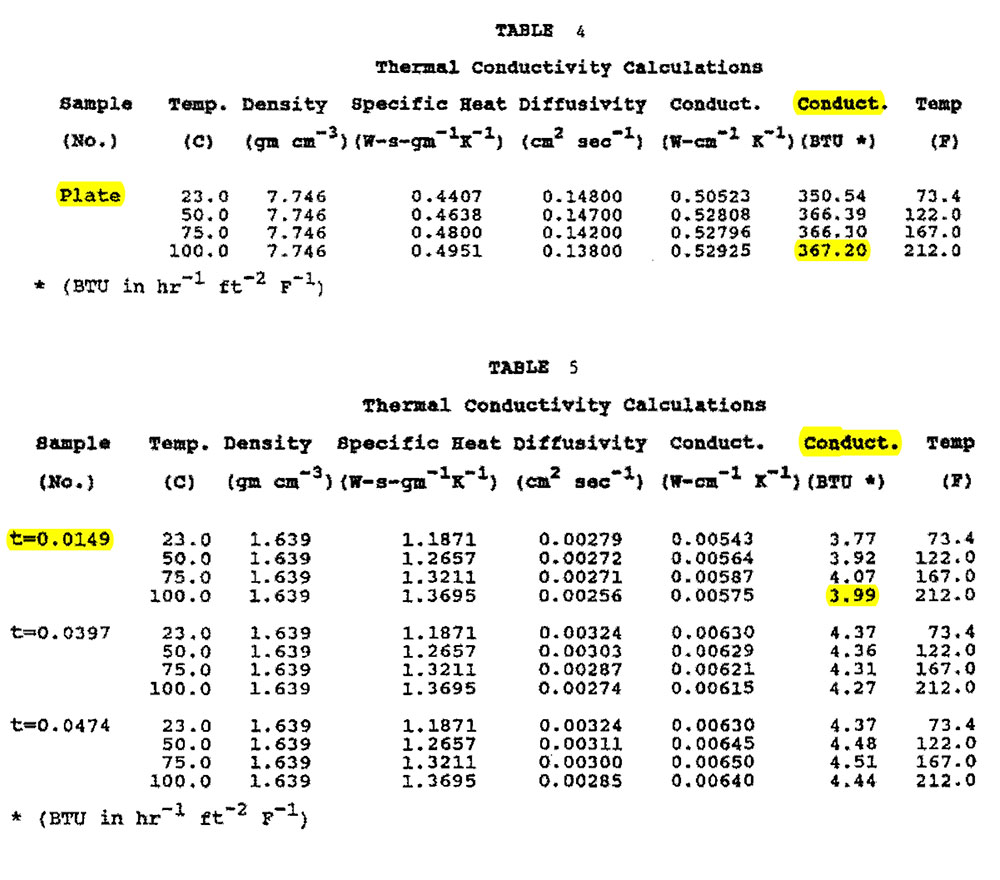
Test Results – PDF
Super Therm® is the only insulation coating globally tested under ASTM E1461 for thermal diffusivity on a metal plate — the correct standard and substrate for real-world energy systems.
- Unlike coatings tested on plastic (ISO 22007-4) — which artificially slow heat and produce misleading results — Super Therm® was tested on conductive metal, simulating real-world conditions like steel roofs, tanks and HVAC systems.
- Result: Thermal diffusivity = 0.256 mm²/s, which is extremely low and confirms its ability to stop heat from penetrating rapidly – the very property that matters in tropical, high-radiation, or industrial climates.
- For context, most metals have diffusivity in the 50–200 mm²/s range. Even fiberglass batts fall between 0.5–1.5 mm²/s. Super Therm‘s result puts it in a category below most insulators, and far beyond any acrylic-based “cool roof” paint.
Why This Matters
- Thermal diffusivity (α) tells you how fast heat penetrates — it’s the missing metric in most insulation marketing.
- A coating with high reflectance but poor diffusivity will still build up internal heat.
- Super Therm® not only reflects — it resists and slows heat penetration at the surface, outperforming thick systems in thin-film form.
Super Therm® High Performance Solar Heat Block Coating Adelaide Test
A field test in Adelaide, South Australia to demonstrate Space Grey (dark) colours and their impact on Super Therm solar blocking and reflectance performance on the top and underside.
- Uncoated galvanised sheet (300mm x 300mm) : -.8°c
- 1 coat of Super Therm® : +5.1°c
- 1 coat of Super Therm® with 1 coat of dark Space Grey paint : +10.6°c
- 2 coats of Super Therm® with 1 coat of dark Space Grey paint : +13.4°c
Work towards zero emissions; reduce your heat load coating
Achieving Coating Energy Efficiency Standards and looking towards Zero Carbon emissions with coatings, Super Therm® will get you there!
- Super Therm® has only 0.559W/m2K of heat conduction with just a 250 micron/0.25mm application.
- Super Therm® offers a heat conduction of just 4BTU/sf/hr. ASTM E1269 BTU Conductivity testing and results.
Super Therm® Tech Sheet
A product like Super Therm® seems too true to believe so naturally its gets far more scrutiny because of its true claims…yet it is that good!
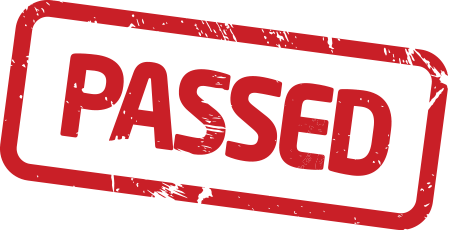
Super Therm® keeps passing testing with flying colours…better than anything else on the market when you compare apples with apples. Super Therm® is developed and manufactured in the USA and the test results show extensive success in independent labs and on site with case studies showing great results around the world including Japan, Russia, China and the USA.
Super Therm® is a water-borne system using high performance aliphatic urethanes, elastomeric acrylics, and resin additives that produce a tough, flexible coating film. Designed for performance and durability, Super Therm® contains four (4) unique ceramics to block up to 95% of solar heat load from visual light, ultra violet, and infrared wavelengths. Super Therm® is a flexible membrane with low permeability that can greatly reduce expansion and contraction of metal by eliminating thermal shock and that can prevent corrosion and surface deterioration.
Key Super Therm® Heat Block Testing
Japan: Japanese Institute of Standards
Cosmo Trade and Services – Japan Testing Centre for Construction Materials. JIS (Japanese Institute of Standards) A 5759 Reflectivity of Light and Radiation for Short Wave (Visual) and Long Wave (Infrared).
- Super Therm blocked Short Wave block – 92.2% (Visual light heat)
- Super Therm blocked Long Wave block – 99.5% (Infrared heat)
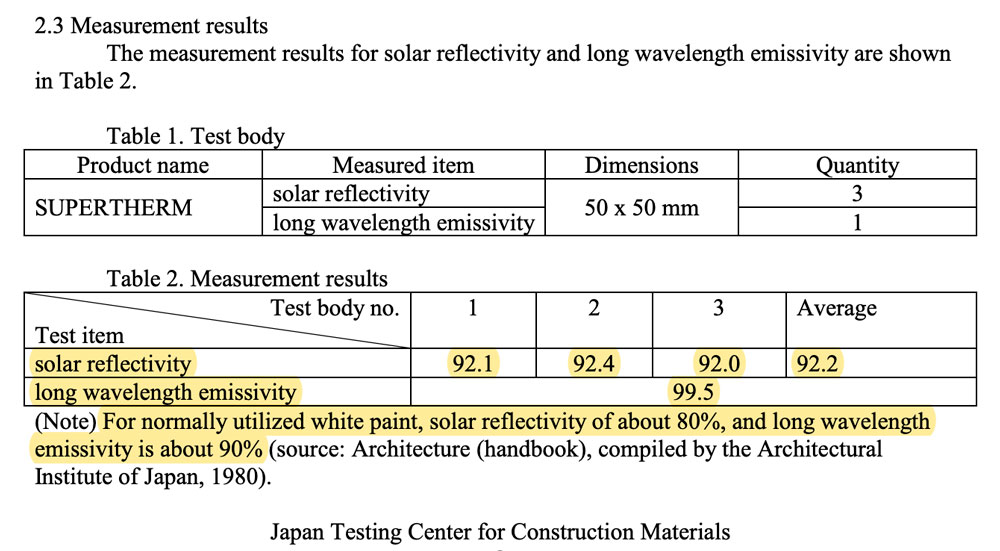
Test Results – PDF
Russia: Super Therm® Russian Academy Science Reflection testing
Testing by the Russian Academy of Sciences on Super Therm® showed how it outperformed a polished mirror in testing results. Research of the coat samples of Super Therm® for reflection of visible and infra-red bands.
Report abstract: It emerged that specular reflection coefficients for all Super Therm coat samples and base material – galvanised iron – practically do not reflect the light specularly in all visible frequency band, where diffused reflection of Super Therm coat appeared to be very effective for diffusion of visible light falling on energy object.
- Super Therm blocked Short Wave block – 95% Avg (Visual light heat)
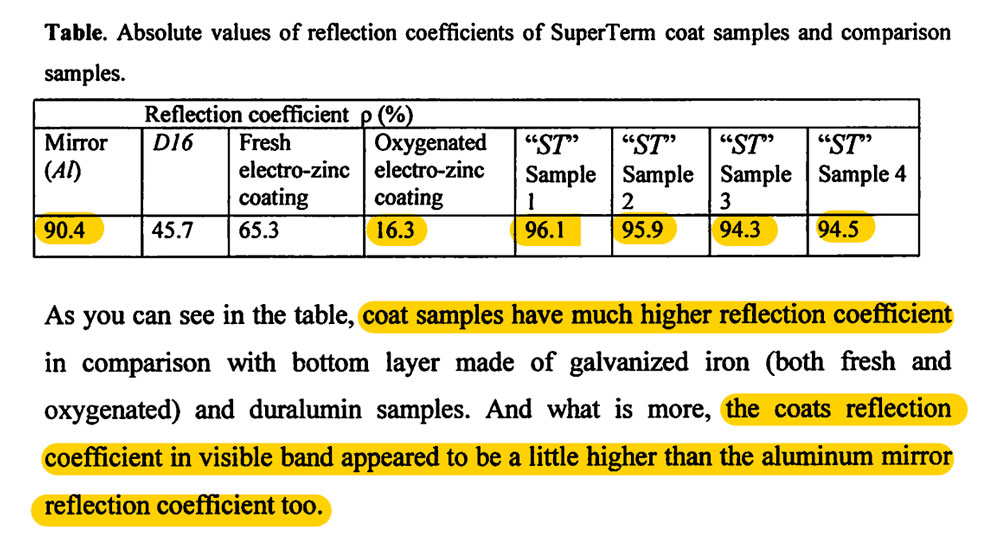
Test Results – PDF
NASA Flammability Test
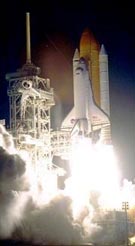
NASA Space Flight Center Testing of Super Therm®. Class A – no flame spread!
In this report NASA tested and classified Super Therm® as a Class “A” rated coating having -0- flame spread in the burn test. Flame spread is rated from “0” being the best to over “100” as being the worst at contributing to flame or fire.
Super Therm® rated excellent in absolutely no contribution to flame or fire. This is an unusual rating for any paint product as most will score from a low of 15 up to 88. The “A” classification is the highest classification that can be achieved. This result definitely shows the quality of Super Therm®.
NASA is currently so impressed with Super Therm® that they are now establishing testing in additional areas of need for the space center. These needs involve not only their facilities but other classified areas.
Test Results – PDF
US Energy Authority Super Therm® Testing

Super Therm® has been thoroughly tested by the US Energy Authority for energy efficient reduction in three locations, Florida, Denver and Texas. It has also passed testing for:
- Exposure to UV, elevated temperature and humidity – passed
- Water Vapour transmission – passed
- Resistance to cracking on metal or rubber type materials – passed
- Tensile Strength – passed
- Flame Spread and smoke generation – passed
- Structure Steel Fire Curve – passed
- Thermal conductivity test – passed
- Salt spray only – 450 hours – passed
- Fungal growth or soil and dirt accumulation on paint film – passed
- Abrasion resistance of organic coatings – passed
- Toxic offgassing – none – passed
- Reflectivity of sunlight on window or coating film – passed
- Environmentally safe and safe for use around animals – passed
- Approved and accepted as energy star partner for reducing energy – passed
Florida Solar Heat Block Coatings Test – US Energy Authority
On February 10th & 11th, 2003 a test was conducted on Super Therm® Solar Heat Block Coating, applied to a residential home roofing system located in Dade County, Florida in accordance with the State of Florida Energy Office / Energy Conservation Assistance Programs Designation: ECAP-CUL-1-99.
As installed, at the time of this testing, the Super Therm® Roof Coating System proved to be an effective Energy Conservation Measure (ECM) that produced a reasonable simple pay back of approximately 2.2 years on this particular project. This would indicate that it’s application could be fundable with Federal and / or State of Florida Energy Grant Dollars where applicable. Note: Results may vary in different conditions and locations.
Full report >
Denver Solar Heat Block Coatings Test – US Energy Authority
On July 19th & 20th,2004 in accordance with the State of Florida Energy Office / Energy Conservation Assistance Programs Designation: ECAP-CUL-1-03 Method for Comparing Utility Loads in Standard Constructed Buildings in Denver, Colorado. The test was over 24 hours between Super Therm® and standard Latex Paint with 2 identical controlled structures. Reports showed it took 30% less energy to heat or cool the building with Super Therm® and moisture levels were reduced. Note: Results may vary in different conditions and locations.
Full report >
Super Therm® Field Retrofitted Shipping Containers Test (pdf – 1.6mb)
On August 23rd & 24th, 2006 a test was conducted in LaPorte, Texas in accordance with the Florida Energy Conservation Assistance Programs Designation: ECAP-CUL-1-03 Method for Comparing Utility Loads in Structures and Buildings.
Utilising shipping containers, the data indicated that at the time of the test specimen container inside surface conduction related energy loads were reduced approximately 46 to 52% by applying Super Therm® as an Energy Conservation Measure (ECM) to outside surfaces.
- Conduction related energy loads were reduced approximately 46 to 52%
- Internal surface temperatures: 20°C (37°F) Cooler
- Outside Surface Reflectivity: 50% Higher
- Ultraviolet absorption rate: 92% Less
- Internal Moisture levels: 28.5% Dryer
Full report >
Comparison of Super Therm® to other reflecting coatings on the market
When tested for Energy Star Program
In the government testing procedures on the products by Insulating Coatings Corporation, Temp-Coat Brand Products, LLC, and SPM Thermoshield, Inc. dba Roof Guardian when tested for Energy Star Program, the testing was performed to demonstrate the reflectivity of a new roof and of a three-year old roof to determine the reduction in reflectivity/performance and loss of insulation effectiveness.
See the original report of the Energy Star Program at www.energystar.gov.
This comparison testing shows very clearly that Super Therm® is the best coating on the market to maintain its insulation ability over the years. The other coatings must be reapplied to maintain any insulation ability. Super Therm® does not have to reapplied.
Full report pdf
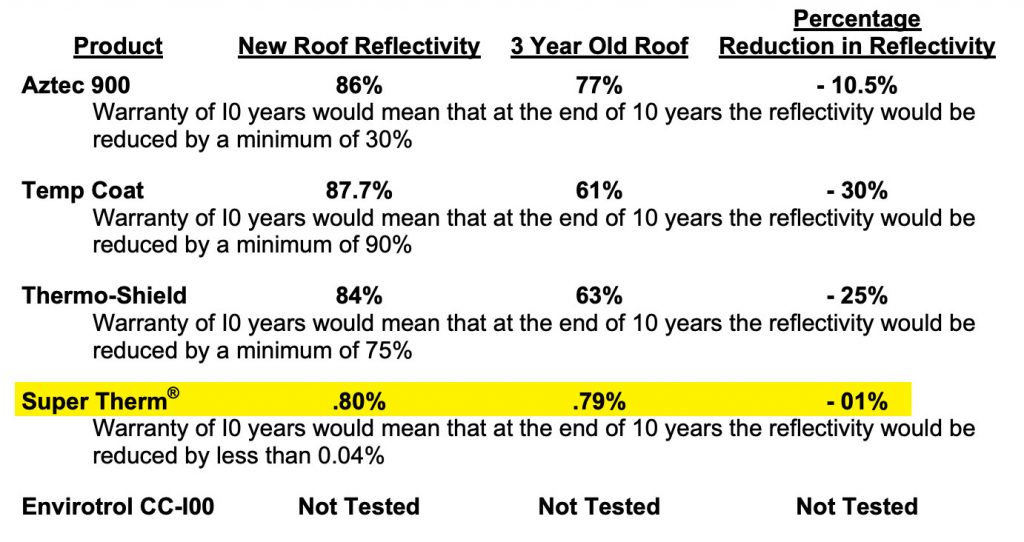

Super Therm® ASTM Test Listing (pdf – 58kb)
American Society of Testing and Materials (ASTM)
- ASTM C 236-89(93) – C1363; Standard Test Method for Thermal Performance of Building Materials and Envelope Assemblies by Means of a Hot Box Apparatus. Thermal Transmittance/Conductance
- Fibreglass board having 0.52 conductance (BTU/square foot/hour/F)
- Super Therm® at 10 mil dry having 0.31 (BTU/square foot/hour/F)
- One coat of both sides of wall, each coat at 10 dry mils having 0.21 (BTU/square foot/hour/F)
- ASTM B-117 / D-1654; Salt Spray (Fog); Results; Passed 450 Hours
- ASTM C-411; High-Temperature Surface Performance; Results; no warping, cracking, de-lamination, or colour change
- ASTM C-1371; Emissivity; Results; 0.91%
- ASTM C-1371; Reflectivity; Results; 0.85%
- ASTM D-412; Tensile Strength; Results; 444 psi
- ASTM E 1461; (92) Thermal Diffusivity/Conductivity by Flash Method Standard BTU (Infrared) flow through metal plate being 367.20 reduced with one coat of Super Therm® to 3.99 – 99.5%
- ASTM 0-522; Mandrel Bend; Results; 1″ (25mm) bend, ¼” (6mm) bend
- ASTM D-1653; Water Vapour Permeability; Results; Passed
- ASTM D 3273-82T / D 327 4; Fungal Resistance; Results; Passed.
- ASTM D-4060; Abrasion Resistance (Taber test); Results; 0.06g
- ASTM D-6904: Resistance to Wind Driven Rain for Exterior Coatings (Fed Spec TT-C-5558)
- ASTM D-7088; Resistance to Hydrostatic Pressure for Coatings (Fed Spec TT-C-555B)
- ASTM E 84 (NFPA 255); Flame Spread / Smoke Developed; Results; Class “A” Rating
- ASTM E 84-89; Flame Spread/ Smoke Developed; Results; Flame Index “0”, Smoke Index “0”
- ASTM E 108 Flame Spread over Pitch Roof Structure – FM Approval
- ASTM E-96; Water Vapour Transmission; Results; Less than .01, Perms 8.8, Class 4 – 457ug/N.S Permeability Rating
- ASTM E 903-96; Spectral Reflectance 83%, Emittance .91 (Very high), SRI 105
- ASTM G 53; 1000 hours UV exposure
- ASTM E 1269; Heat Capacity by Differential Scanning Colorimeter
- ASTM D 4541; Standard Method for Pull-off Strength (Result: 191psi – 13.37 bar strength)
- ASTM D 794; Determine Wet Adhesion Results. Wet adhesion to Galvanised Steel (Result: 3.6 – Required ≥ 2.0)
China Centre for Technical Testing
- GB/T 1771-91 Resistance to Salt Fog (2000 hours) – passed
- GB/T 1866-88 Manual Ageing (2000 hours) – passed
- GB/T 10834-88 Resistance to Salt Water (1000 hours) – passed
- GB/T 5219-85 Adhesion (Pulling Apart Method) (6.72MPa) – passed
- GB/T 1733-93 Boiling Water Immersion (8 hours) – passed.
Other Testing Results
- International Maritime Association: IMO A.653.(16) Flame Spread Test passed for Bulkhead, wall and ceiling linings.
- NASA (National Aeronautic and Space Administration) NASA 8060.1 B/C Flammability Test – passed, Class A with “0” flame spread
- NASA 8060.1 C Toxic Off-gassing Test “K” rating for “0” off gassing
- ABS (American Bureau of Shipping) testing, IMO (International Maritime Org) and US Coast Guard Approval. MSC 41, Smoke Toxicity – passed
- ASTM G53 – Practice for Operating Light- and Water-Exposure Apparatus (Fluorescent UV-Condensation Type) for Exposure of Nonmetallic Materials (Withdrawn 2000)
- ASTM E96 – Standard Test Methods for Water Vapor Transmission of Materials
- ASTM D522 – Standard Test Methods for Mandrel Bend Test of Attached Organic Coatings
- ASTM D412 – Standard Test Methods for Vulcanized Rubber and Thermoplastic Elastomers—Tension
- ASTM D1653 – Standard Test Methods for Water Vapor Transmission of Organic Coating Films
- ASTM E 84-89 – Standard Test Method for Surface Burning Characteristics of Building Materials
- ASTM E 119 – Standard Test Methods for Fire Tests of Building Construction and Materials
- ASTM C 177 – Standard Test Method for Steady-State Heat Flux Measurements and Thermal Transmission Properties by Means of the Guarded-Hot-Plate Apparatus
- ASTM C 411 – Standard Test Method for Hot-Surface Performance of High-Temperature Thermal Insulation
- ASTM E1269 – Standard Test Method for Determining Specific Heat Capacity by Differential Scanning Calorimetry
- ASTM E1461-92 – Standard Test Method for Thermal Diffusivity of Solids by the Flash Method
- ASTM D1654 – Standard Test Method for Evaluation of Painted or Coated Specimens Subjected to Corrosive Environments
- ASTM D3274 – Standard Test Method for Evaluating Degree of Surface Disfigurement of Paint Films by Fungal or Algal Growth, or Soil and Dirt Accumulation
- ASTM D4060 – Standard Test Method for Abrasion Resistance of Organic Coatings by the Taber Abraser
- ASTM E-903-96 – Standard Test Method for Solar Absorptance, Reflectance, and Transmittance of Materials Using Integrating Spheres
- ASTM E-1918 – Standard Test Method for Measuring Solar Reflectance of Horizontal and Low-Sloped Surfaces in the Field
- JIS A-5759 – (Japanese Standards) Adhesive films for glazings
- USDA M0729 – Standards
- BOCA Section 723.2
- BOCA Section 723.3
- BOCA Section 803.2
- BOCA 1998 International Mechanical Code Section 604.3

ASTM B117 Salt Spray Tests (pdf – 40kb)
Northwest Testing Laboratories, Salt Spray Corrosion Tests.
ASTM C1363 (C236): Fiberglass Batt insulation comparison (pdf – 1.5mb)
Super Therm® tested by VTEC Laboratories. Super Therm® proved to be 240% better than fiberglass insulation. Super Therm® performs equally from -50 to 300F and is never affected by moisture.
Test results compared with other reflective coatings (pdf – 1.5mb)
Energy Star Program comparison testing shows very clearly that Super Therm® is the best coating on the market to maintain its reflective ability over 3 years with just 1% loss.
Sound Proof Test (pdf – 531kb)
Sound Testing performed by Hot-Cold Air and Fire Control by Pat Saulson, PhD. Sound reduced on average 50% for interior walls and 23% for exterior walls.
Resistance to Growth of Mould ASTMD-3273-82T
Resistance to growth of mould in severe mould environments. Buckman Laboratories International, Technical Service Laboratory Report.
ASTM Tests (pdf – 58kb)
ASTM G53, ASTMD1653, ASTMD4060, ASTME96, ASTMD522, ASTMD412
- Visual effect of UV exposure – passed
- Water vapour permeability on organic coatings
- Abrasion resistance on organic coatings
- Water vapour transmission on materials
- Mandrel Bend test
- Tensile properties
BOCA Building Code Report (pdf – 91kb)
BOCA International Evaluation Report. US National Building Code 1999 – endorsement of Super Therm®.
Chicken House Test (pdf – 91kb)
Perimeter Industries Test Chicken House Roof – Cold storage facility for Jacks Hamburgers and Subway Foods, Cagle Foods.
Coke Pusher Cab (pdf – 251kb)
Sloss Industries Testing Documentation for Perimeter Industries, Coke Pusher Cabs Test, Stand Pipe Test, Steam Pipe Test, Oven Door Plug Test, Leveling Door Castings, Summary and Recommendations.
Ecopetrol Test (pdf – 80kb)
Ecopetrol Certification. Use of Super Therm® instead of Aluminium foil for insulation.
Emittance Test (pdf – 87kb)
Tennesse Tech Emittance Test.
Jet Engine Thruster Test (pdf – 250kb)
Jet Engine Reverse Thruster Test, (see graphs in pdf).
USDA Approval (pdf – 470kb)
Super Therm® is chemically acceptable as a coating for application to structural surfaces or surfaces where there is a possibility of incidental food contact in official establishments operating under the Federal meat and poultry products inspection program (pdf).
Purdue University: Emerging Construction Technologies
Super Therm® as an Energy Reducing Ceramic Cool Insulation Coating is Engineered to Block Solar Heat by deflecting, repelling and emitting thermal absorptance which reduces the solar heat being absorbed by 96.1% on an exterior application. As noted by a PhD in Fluid Mechanics, on exterior applications “SuperTherm® is deflecting better than 95% of the heat to begin with therefore debating the remaining 5% is trivial.”.
This was validated by the first certified thermal test conducted for Super Therm® being ASTM E1269 Standard Test Method for Determining Specific Heat Capacity by Differential Scanning Calorimetry in conjunction with ASTM E1461-92 Standard Test Method for Thermal Diffusivity of Solids by the Flash Method.
This was the certified ASTM testing recommended by the thermal laboratory located at Purdue University as it measures the thermal absorptance of the coating independent of the substrate to which it is applied.
This certified ASTM testing, documents the fact that Super Therm® reduced BTU’s absorbed from over 350+ BTU’s per hr\ft2\F on a bare metal substrate (Table 4) down to 4 BTU’s absorbed per hr\ft2\F on the metal substrate coated with Super Therm® (Table 5).
Purdue University Super Therm® Case Study




